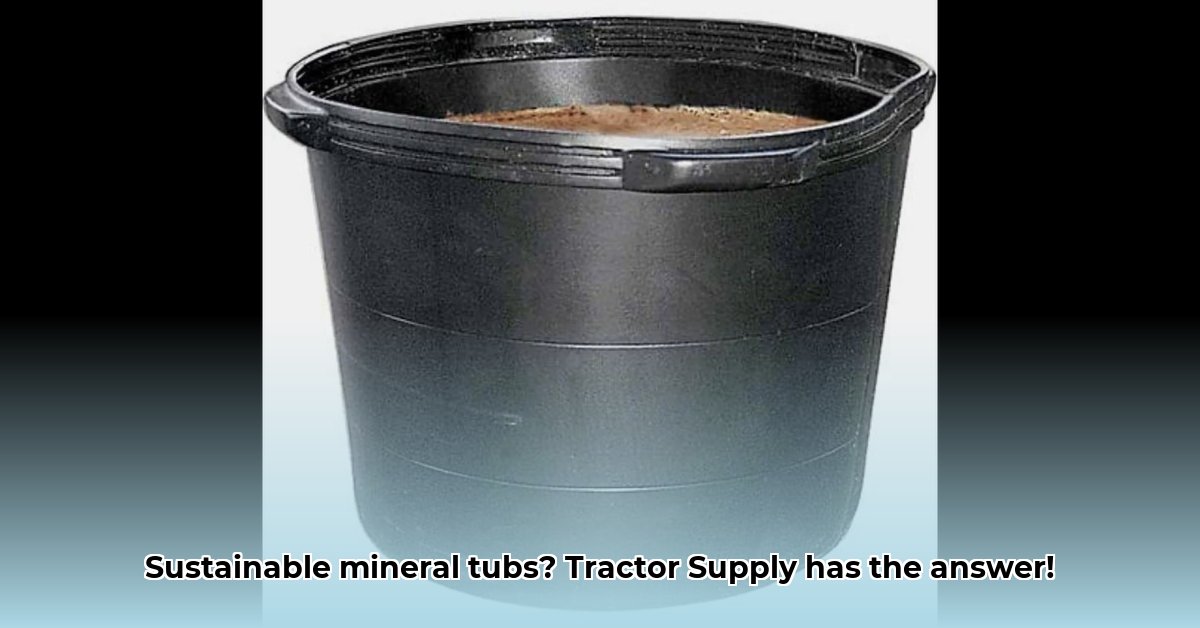
Understanding High-Protein Mineral Tubs in Livestock Farming
High-protein mineral tubs, readily available at retailers like Tractor Supply and Rural King, are a common supplement in livestock farming. These tubs, typically weighing 200 pounds and containing around 24% protein, aim to ensure livestock receive essential nutrients for optimal health and productivity. However, growing concerns about sustainability are prompting a closer examination of these products' environmental impact. This article investigates the sustainability of these mineral tubs, highlighting data gaps and advocating for increased transparency and research.
The 24% Protein Puzzle: A Lack of Transparency
While 24% protein content is a common feature of mineral tubs at Tractor Supply and similar retailers, crucial information regarding ingredient sourcing and manufacturing processes is often missing. This opacity hinders a comprehensive evaluation of their environmental footprint. Do we really understand the full impact of these seemingly simple products on the environment? It's a question that demands attention.
Sustainability Concerns: Unanswered Questions
Assessing the environmental impact of high-protein mineral tubs requires careful consideration of several factors:
1. Feedstock Sustainability: The lack of detailed ingredient lists prevents a thorough analysis of the feedstock’s origin and production methods. Are ingredients sourced sustainably, or do their production processes contribute to deforestation, water pollution, or high greenhouse gas emissions? This crucial information is often unavailable to consumers. How can we make informed choices without complete transparency?
2. Mineral Sourcing: The mining practices involved in acquiring minerals used in these tubs pose potential environmental and ethical concerns. What are the environmental consequences of mineral extraction? Are fair labor practices followed? The absence of information on mineral sourcing presents a significant obstacle to a complete sustainability assessment. Without transparent sourcing information, are we unknowingly supporting unsustainable practices?
3. Packaging Impact: The substantial plastic tubs and their packaging contribute to the overall environmental footprint. The recyclability of materials and the carbon emissions associated with transportation are critical factors often overlooked. Are there more sustainable packaging solutions available? What is the lifecycle cost of this packaging, from manufacturing to disposal?
4. Nutrient Utilization: Even with sustainably sourced ingredients, the effectiveness of nutrient utilization by livestock remains a key consideration. Inefficient nutrient absorption translates to wasted resources and an increased environmental footprint. How can we optimize nutrient bioavailability to minimize waste and maximize the benefit of these products? Further research is essential.
Stakeholder Perspectives: Shared Responsibility
Addressing the sustainability challenges of mineral tubs requires a coordinated effort among various stakeholders:
Farmers: Informed decision-making by farmers is critical, needing clear and accessible data to choose more sustainable options.
Feed Suppliers: Transparency in ingredient sourcing and manufacturing processes is vital. Suppliers must adopt more rigorous environmental and ethical standards.
Retailers: Retailers like Tractor Supply have a significant role in driving industry-wide change by promoting and procuring sustainable products. They can leverage their influence to demand better transparency from their suppliers.
Regulatory Bodies: Governments need to implement clear regulations to ensure accurate labeling, promote sustainable practices, and incentivize environmentally friendly alternatives through policies and incentives.
Research Institutions: Further research is crucial to address knowledge gaps regarding sustainable sourcing, optimal nutrient utilization, and eco-friendly packaging design.
A Call to Action: Promoting Sustainable Practices
Achieving a truly sustainable livestock farming system demands immediate and collective action:
Demand Transparency: Consumers should actively contact manufacturers and retailers, demanding detailed ingredient lists and information on sourcing practices. Transparency is paramount for informed decision-making.
Support Sustainable Alternatives: Consumers can actively support manufacturers who prioritize sustainability through their purchasing choices; this market response shapes industry practices.
Advocate for Stronger Regulations: Engage with policymakers to push for better labeling requirements and stricter regulations for sustainable agricultural practices. Pressure from consumers drives change.
Invest in Research: Support research dedicated to improving sustainability in livestock feed production. Data-driven insights guide the path to more responsible practices.
Conclusion: Towards a Sustainable Future
High-protein mineral tubs are vital for livestock health, but their sustainability remains a critical concern. The current lack of transparency regarding ingredient sourcing, manufacturing processes, and packaging hampers informed decision-making. A collaborative approach involving farmers, suppliers, retailers, regulators, and researchers is crucial to move towards a truly sustainable future in livestock farming. Demanding transparency, supporting sustainable initiatives, and advocating for change are critical steps toward ensuring a healthier planet.